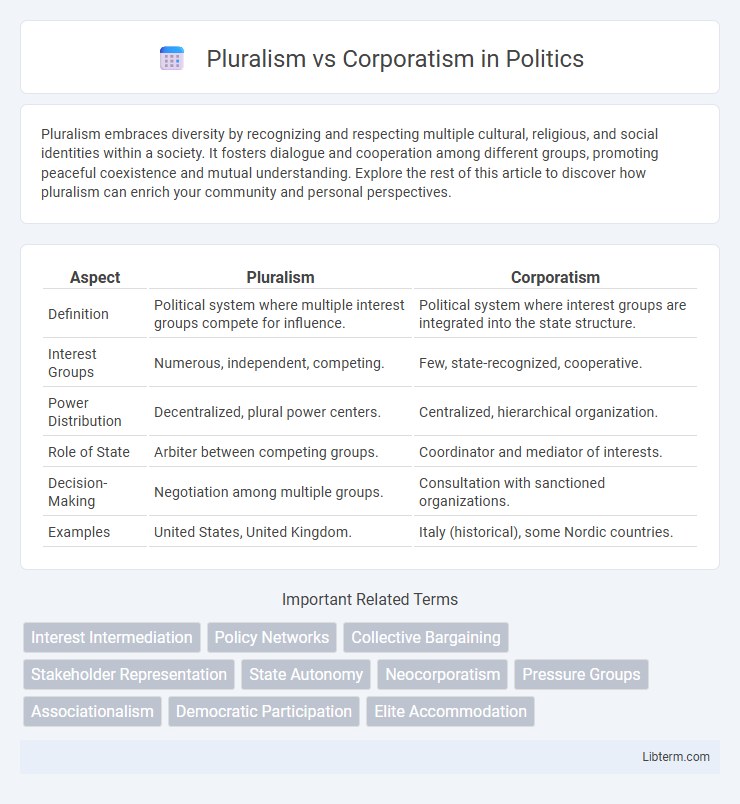Pluralism embraces diversity by recognizing and respecting multiple cultural, religious, and social identities within a society. It fosters dialogue and cooperation among different groups, promoting peaceful coexistence and mutual understanding. Explore the rest of this article to discover how pluralism can enrich your community and personal perspectives.
Table of Comparison
| Aspect | Pluralism | Corporatism |
|---|---|---|
| Definition | Political system where multiple interest groups compete for influence. | Political system where interest groups are integrated into the state structure. |
| Interest Groups | Numerous, independent, competing. | Few, state-recognized, cooperative. |
| Power Distribution | Decentralized, plural power centers. | Centralized, hierarchical organization. |
| Role of State | Arbiter between competing groups. | Coordinator and mediator of interests. |
| Decision-Making | Negotiation among multiple groups. | Consultation with sanctioned organizations. |
| Examples | United States, United Kingdom. | Italy (historical), some Nordic countries. |
Defining Pluralism and Corporatism
Pluralism is a political theory emphasizing multiple, competing interest groups that influence policy-making through open participation and decentralized power. Corporatism structures society by organizing interest groups into officially recognized entities that collaborate closely with the state to formulate policies, often limiting competition among groups. The distinction lies in pluralism's advocacy for diverse, autonomous groups versus corporatism's centralized integration of groups within state mechanisms.
Historical Origins and Development
Pluralism emerged from the liberal democratic traditions of the 18th and 19th centuries, emphasizing diverse interest groups competing within an open political system to influence policy. Corporatism originated in the late 19th and early 20th centuries, particularly in Europe, where state-sanctioned interest groups, such as labor and business organizations, were integrated into the policymaking process to promote social harmony and economic coordination. The development of pluralism coincided with expanding suffrage and rights, while corporatism often aligned with authoritarian regimes seeking controlled collaboration between social sectors.
Key Principles of Pluralism
Pluralism emphasizes the dispersion of power among diverse and competing interest groups, ensuring no single entity dominates political decision-making. It supports open access to the policy process, promoting negotiation, compromise, and the representation of varied social interests. This approach values decentralization, active citizen participation, and the protection of minority rights within democratic governance.
Core Features of Corporatism
Corporatism is characterized by the organization of society into corporate groups, such as labor, business, and professional sectors, which collaborate directly with the state to influence policy-making and economic planning. These groups function as intermediaries between individuals and the government, fostering structured cooperation and reducing social conflict through negotiated agreements. Unlike pluralism, corporatism emphasizes integrated representation, where sanctioned interest groups hold official roles in governance, often limiting competitive political participation.
Political Representation in Both Systems
Pluralism promotes political representation through diverse interest groups competing in an open marketplace of ideas, ensuring multiple voices influence policy decisions. Corporatism structures political representation by integrating selected interest groups directly into the policymaking process, often prioritizing organized labor, business, and state actors as official intermediaries. This arrangement limits competition by giving privileged representation to specific sectors, potentially marginalizing less organized or informal groups.
Influence on Policy-Making
Pluralism emphasizes diverse interest groups competing to influence policy-making, ensuring a balance of power and preventing dominance by any single group. Corporatism centralizes policy influence within a limited number of large, organized interest groups, such as labor unions and business associations, which collaborate directly with the government. This collaboration often leads to negotiated policy outcomes that reflect the interests of key economic sectors rather than a wide array of competing voices.
Role of Interest Groups
Interest groups in pluralism operate independently, competing openly to influence public policy and represent diverse societal interests without state control. In corporatism, interest groups are integrated into the state framework, often formally recognized and sometimes controlled to negotiate policy collaboratively with the government. This structured partnership in corporatism contrasts with pluralism's decentralized competition, affecting how policies reflect societal interests.
Advantages and Challenges
Pluralism enhances democratic participation by allowing multiple interest groups to influence policy, promoting diversity and preventing dominance by a single entity. Corporatism facilitates structured collaboration between government, businesses, and labor, leading to more coordinated and stable economic and social outcomes. Challenges of pluralism include potential policy gridlock and unequal power among groups, while corporatism risks limiting competition and marginalizing dissenting voices.
Impact on Democratic Governance
Pluralism fosters democratic governance by encouraging diverse interest groups to participate in policy-making, ensuring broad representation and accountability. Corporatism, by integrating select organizations into formal decision-making processes, can streamline policy implementation but risks marginalizing minority voices and concentrating power among elite groups. The impact on democracy depends on the balance between inclusive participation and efficient coordination within political institutions.
Contemporary Examples and Case Studies
Contemporary examples of pluralism are evident in the United States where interest groups like the NRA and environmental organizations compete openly to influence policy, exemplifying a decentralized power structure. In contrast, corporatism is prominent in countries such as Sweden, where the government collaborates closely with major labor unions and employer associations to negotiate social and economic policies, reflecting a structured partnership model. Case studies from Germany show a hybrid system where both pluralist competition and corporatist arrangements coexist, balancing diverse stakeholder interests in policy-making processes.
Pluralism Infographic

 libterm.com
libterm.com